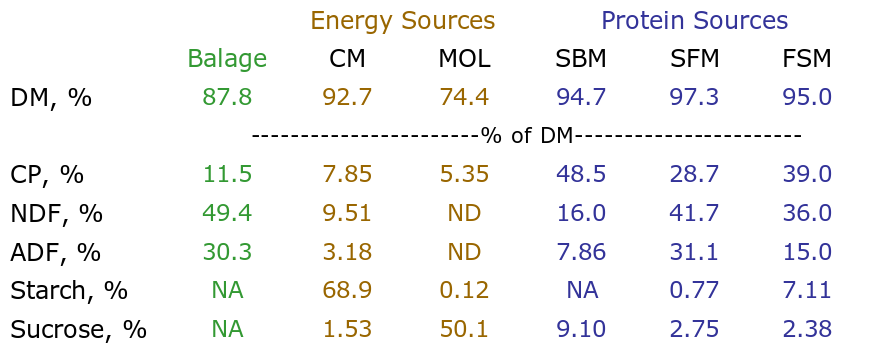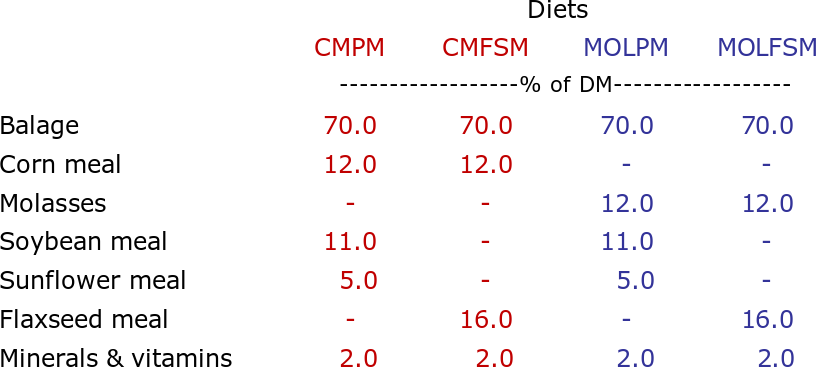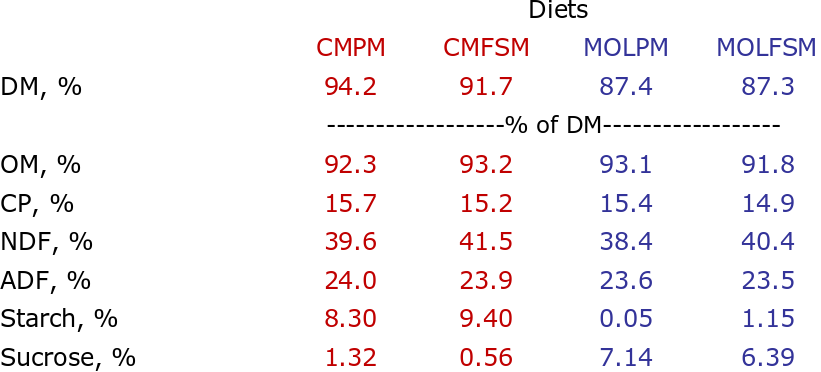Session 1
Molasses Supplementation to Organic Dairy Cows
Dr. Andre Brito, assistant professor of dairy nutrition, University of
New Hampshire
Molasses is a rich source of sugars, particularly sucrose. Compared to starch, sucrose enhanced the net yield of microbial protein synthesis in the rumen (Stokes et al., 1991). Sugars are more quickly degraded in the rumen than starch (Chamberlain et al., 1993). Replacing high moisture shelled corn with incremental levels of dried or liquid molasses reduced rumen ammonia N and urinary N excretion (Broderick & Radloff, 2004).
In the rumen there must be a balance between adenosine triphosphate (ATP) energy and rumen degradable protein so that nitrogen is efficiently used to produce milk in the lactating dairy cow. When it is in balance, the nitrogen ingested by the lactating dairy cow is proportioned in this fashion: 25-35% of it is converted into milk nitrogen, 30-40% into fecal nitrogen, and 35-45% as urinary nitrogen. With precision feeding to keep this balance between energy and rumen degradable protein, it maximizes milk production while dampening the amount of nitrogen excreted in the urine and fecal matter. The testable hypothesis of using molasses is to increase energy levels in the feed to better utilize the rumen degradable protein ingested by cows on pasture.
In the experiment this presentation covered, the objective was to compare the effects of feeding either corn meal or molasses, with or without a protein supplement - flaxseed meal or a soybean-sunflower mix, had on milk production, milk composition, nutrient intake, and apparent total tract digestibility of nutrients. Sixteen lactating Jersey cows were used in 4 replicated treatments using 4 x 4 Latin squares with a 2 x 2 factorial arrangement. Each treatment period lasted 21 days with 16 days for diet adaptation and 5 days for data and samples collection. The cows were individually fed twice a day with refusals recorded daily before each feeding. Milk production was recorded throughout the 84-day study. Body weight and BCS were recorded every period. Balage was the forage used, not pasture.
The data and samples collected were:
- Feed samples: DM, organic matter (OM), CP, NDF, ADF, AIA, starch, and sucrose
- Blood samples: plasma urea nitrogen (PUN) and non-esterified fatty acids (NEFA)
- Urine samples: total N, urea N, creatinine, and purine derivative (PD) [predicts microbial mass flowing out of the rumen]
- Milk samples: fat, true protein, lactose, MUN, and fatty acids
- Fecal samples: DM, OM, CP, NDF, ADF, and AIA
The data were analyzed using the MIXED procedure of SAS.
Chemical Composition of Dietary Ingredients
[
- CM = corn meal; MOL = molasses
- SBM = soybean meal; SFM = sunflower meal; FSM = flaxseed meal
- NA = not analyzed
- ND = not detected
Ingredient Composition of Diets
[
- CMPM = corn meal + protein mix (soybean meal + sunflower meal)
- CMFSM = corn meal + flaxseed meal
- MOLPM = molasses + protein mix
- MOLFSM = molasses + flaxseed meal
Chemical Composition of the 4 Diets
[
- CMPM = corn meal + protein mix
- CMFSM = corn meal + flaxseed meal
- MOLPM = molasses + protein mix
- MOLFSM = molasses + flaxseed meal
The first table above shows the chemical composition of the dietary ingredients used in the experiment. Note that molasses (MOL) has no fiber, acid detergent fiber (ADF) and NDF values. Starch is virtually nonexistent in molasses, but it is 50% sucrose (sugar). Meanwhile corn meal (CM) is 69% starch. Of the protein sources flaxseed meal had 7% starch, while sunflower meal (SFM) contained less than 1% starch and soybean meal (SBM) was not analyzed for starch.
The second table displays the composition of the 4 rations fed during the experiment. Balage held constant at 70% of DM intake. Minerals and vitamins were held constant at 2% of DM.
The table of chemical composition of the 4 diets shows that as closely as possible OM, CP, NDF, ADF were held constant. Only the starch and sucrose numbers changed from one diet to the next.
The two diets containing flaxseed meal (CMFSM and MOLFSM) depressed milk production, while the corn meal and protein mix (CMPM) and molasses and protein mix (MOLPM) diets produced the highest milk production. The latter two diets produced just over 14 kilograms (31 pounds) of milk per day per Jersey cow. Feed efficiency (milk yield:DM intake) decreased significantly with the molasses and flaxseed meal supplement diet. The energy source (corn meal or molasses) had no effect on milk fat or protein. While the protein source (soybean meal + sunflower meal or flaxseed meal) had a significant effect.
Flaxseed meal increased milk fat content but produced lower total milk fat produced per day due to the reduction in milk yield. Flaxseed meal also increased milk protein content but lowered total milk protein produced per day as a result of lower milk yield. Both energy source and protein source affected PUN levels. Molasses decreased PUN compared to corn meal, and flaxseed meal lowered PUN compared to soybean meal + sunflower meal. However, the PUN concentrations were just slightly over or less than 19 mg/dl. (Ed. note: PUN and MUN concentrations > 19 mg/dl have been associated with approximately a 20 percentage point decrease in pregnancy rate after artificial insemination in lactating dairy cattle. [Butler et al., 1996])
With flaxseed meal fed along with corn meal, MUN increased to 17.4 mg/dl compared to corn meal fed along with soybean meal + sunflower meal, MUN = 15.7 mg/dl With molasses the opposite effect occurred with MUN decreasing when flaxseed meal was fed along with molasses, 14.9 mg/dl, versus 15.6 mg/dl when molasses was fed with soybean meal + sunflower meal. (Ed. note: Still above the recommended range for MUN of between 8 and 12 mg/dl)